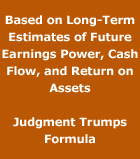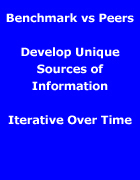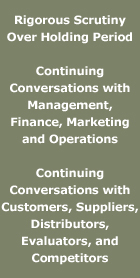 |
INVESTMENT PROCESS |
| |
|
|
|
At
Lapides Asset Management, our goal is to generate a meaningful absolute
return within an attractive overall risk profile for our clients. If
our investment philosophy is the strategic basis for making
investments, it follows that our investment process defines the tactics
that lead toward a purchase. As we move through this process, we first discover a suitable candidate, then understand its business and products, in order to best value its worth. Only when the reward for the risk taken is significantly attractive will we purchase shares. Once the investment is in our portfolio, we continually monitor our original thesis, and ultimately sell
- hopefully at a significant gain. Importantly, a strong appreciation
for minimizing risk underlies everything we do. Our aim is to find for
our clients' portfolios the right companies at the right time at the
right price. Please click below to read more on each step. |
 |
 |
 |
 |
 |
 |
 |
 |
 |
 |
 |
|
|
|
|
|
|
Measure Value |
Build Mosaic |
Monitor Thesis |
Sell Appropriately |
 |
| |
Manage Risk |
|
| |
|
|
|
|
|
|
We
acquire our information directly and unfiltered, then combine it with
our knowledge of underlying industry dynamics. The cumulative and
generalist nature of our research team's experience is key to our
ability to connect the many dots.
Through
comprehensive on-site visits and exhaustive, in-depth interviews with
companies all over the world, we develop a deeper understanding of
potentially attractive investments. For us, a typical site visit to a
company provides not only intelligence on a firm; it also provides an
opportunity to learn about a company's distributors, vendors,
competitors, and customers.
A
skilled analyst is always prospecting - searching far and wide. Good
ideas can come from anywhere. In fact, it's almost easier to say where
our ideas do not come from: the brokerage community or from screening financial databases.
Our
objective is to find good companies that - for some temporary,
identifiable and correctable reason - have a discounted valuation in
the marketplace. Under the right leadership, performance and perception
can materially improve. Buying our investments when they are out of
favor allows us to bridge the gap between a company's current value and
where it should be valued - the profitable transition over time from hidden gem into coveted jewel. |
|
|
|
|
Each
of our investments must have a discount valuation and financial
flexibility within the context of meaningful - however unrecognized -
internal change.
Our
valuation process begins with traditional metrics such as the
price-to-earnings ratio, enterprise value to EBITDA, and free cash flow
analysis. Importantly, our valuations are based on long-term operating
metrics and are measured against comparables. We are nevertheless aware
of the limits of assumptions in mathematical calculations, so judgment
and experience always trump a strictly formulaic approach.
Financial
flexibility is having the wherewithal to achieve the long-term
strategic objectives that we believe are critical to reaching our
investment premise. During this phase of the investment process,
determining whether or not a company has financial flexibility and is
trading at a sufficient discount is essential before proceeding. |
|
|
|
|
|
Our
process has always been differentiated by its research-intensive
nature. The ancients built their mosaics by piecing together many small
stones to create a picture. Our research methodology is likewise
hands-on, time-consuming and enhanced by our investment team's decades
of experience researching companies around the globe. We build our
mosaics out of small pebbles of information - some picked up right off
the ground while many more are buried deep beneath the surface.
To
be successful in an investment, an investor must have an edge in
information or an edge in perspective. We buy a stock when we believe
we have that edge. Again, each Lapides investment must have a discount
valuation and financial flexibility within the context of meaningful -
however unrecognized - internal change. An understanding of that
meaningful change is the picture our research mosaics yield. |
|
|
|
|
Monitoring
our thesis takes many different forms, but we believe the real work
begins once the first share is purchased, when we intensify the process
of substantiating our thesis and continually evaluating its validity.
This part of the process goes on for as long as we own a company's
securities, and even after, as we may own a stock more than once. Our
thesis must withstand rigorous scrutiny during the holding period. We
spend a great deal of time discussing issues and conditions with
persons deeply involved in the company or industry: line and staff
executives, other current and former employees, customers, competitors,
distributors, vendors and anyone else in a position to evaluate the
company's strategies and capabilities.
Importantly, we have the discipline to reappraise or readjust for significant events and changing environments. |
|
|
|
|
Before
determining whether it is appropriate to sell a company's stock, we
believe one must have a clear idea of why it was bought in the first
place, underscoring the importance of building the mosaic and
monitoring our original thesis.
Our sell
discipline embodies balancing our expectations and the original thesis
against the relative size of the position in the portfolio. If the
company's stock price fully reflects the impact of the meaningful
internal change that was the original basis for our investment, the
position is sold. We also sell when the markets become much more
enthusiastic about our holding than we are - and that heightened
enthusiasm is reflected in the valuation. Of course, if we recognize
that we have made a mistake in our initial analysis or if significant
events alter the potential housed in our thesis, we will also sell.
We
approach our sell discipline with an acute sensitivity to other
investors' expectations, knowing that their ever-changing perspectives
compel us to manage our positions proactively. We are fully aware that
selling appropriately involves balancing the concept of "leaving money
on the table" against the knowledge that risk escalates with a rising
valuation. Just as we accumulate our holdings in stages, we typically
"average out" when selling. Our cash position is a residual of the
process. |
|
|
|
|
|
We
manage risk every step of the way. When prospecting for
opportunities, we must be able to understand the business. When
valuing companies, we are extremely sensitive to our assumptions,
trying to consider everything that can go wrong. By combining our
deep understanding with our conviction in a company, and by buying that
company's equity at a meaningful discount to its potential value, we
seek to limit our downside considerably (thus preserving capital and
creating the opportunity for meaningful upside). We also create the
ability to further enhance our over-all risk/reward profile by
"averaging down", purchasing more of a company's stock when the firm's
stock price falls. Always conscious of the price impact of a sale
at market, we are patient sellers, and we tend to "average out" over
time. |
|
|
|
|
|
|
| |

